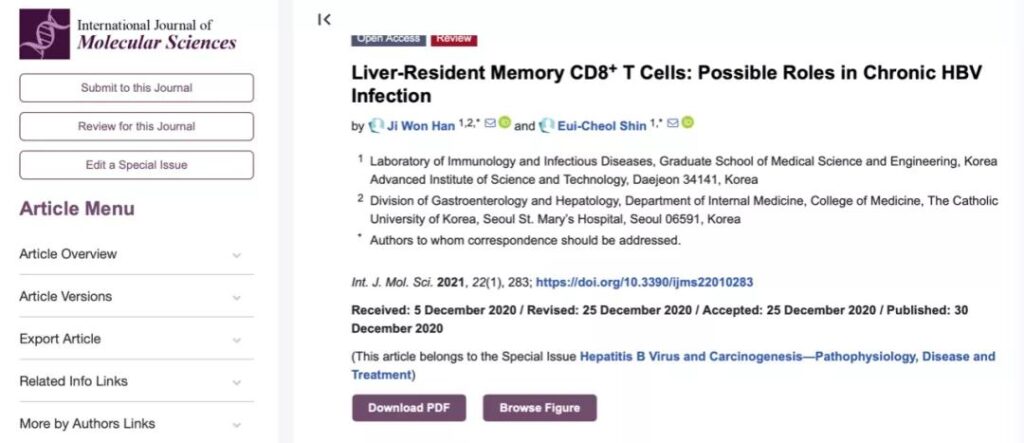New target of Hepatitis B: Potential role of liver TRM cells
- A Single US$2.15-Million Injection to Block 90% of Cancer Cell Formation
- WIV: Prevention of New Disease X and Investigation of the Origin of COVID-19
- Why Botulinum Toxin Reigns as One of the Deadliest Poisons?
- FDA Approves Pfizer’s One-Time Gene Therapy for Hemophilia B: $3.5 Million per Dose
- Aspirin: Study Finds Greater Benefits for These Colorectal Cancer Patients
- Cancer Can Occur Without Genetic Mutations?
New target of Hepatitis B: Potential role of liver TRM cells
New target of Hepatitis B: Potential role of liver TRM cells. The target of new hepatitis B drug development, described by Korean scientists, the potential role of liver TRM cells.
At the end of 2020, researchers from the Laboratory of Immunology and Infectious Diseases, Graduate School of Medical Science and Engineering, Daejeon University of Science and Technology, South Korea, and the Department of Gastroenterology, St. Mary’s Hospital, Seoul University, South Korea, discovered that it can be used as an immunotherapy target for the treatment of chronic HBV infection and published in “International Journal of Molecular Sciences” (International Journal of Molecular Sciences).

The target of new hepatitis B drug development, described by Korean scientists, the potential role of liver TRM cells
According to Korean researchers, achieving functional cure of chronic hepatitis B virus (HBV) infection or complete elimination of HBV’s covalent closed circular DNA (cccDNA) has always been a challenge for the treatment of patients with chronic HBV infection. Although new antiviral drugs are being studied, improving the HBV-specific adaptive immune response is also one of the important and long-lasting methods to eliminate the virus. Tissue resident memory CD8+T (TRM) cells are a group of T cells that exist in peripheral tissues and are no longer circulating.
The TRM cells in mouse and human livers were studied. Compared with T cells in peripheral blood or other tissues, liver TRM cells have obvious characteristics, which may be related to the unique microenvironment of the liver. In this review, Korean researchers described the characteristics of liver TRM cells and their significance in chronic HBV infection. At the same time, it is emphasized that liver TRM cells can be used as immunotherapy targets for the treatment of chronic HBV infection. Although effective antiviral drugs have been developed around the world, current antiviral treatments cannot eliminate the covalently closed circular DNA (cccDNA) in infected liver cells.

The persistence of cccDNA is a persistent mode of HBV genome. In addition, HBV specific immune response is not enough to eliminate hepatitis B virus in chronic HBV infection. In order to effectively control the hepatitis B virus, Korean researchers have observed that the synergy of innate and adaptive immune responses is crucial. CD8+ cytotoxic T cells play a major role in the adaptive immune system. They can specifically recognize viral epitopes on class I molecules of the major compatibility complex, thereby killing virus-infected cells or releasing antiviral cytokines, and then Eliminate the virus.
A recent human trial showed that blocking programmed cell death-1 (PD-1) can partially reduce the level of hepatitis B surface antigen (HBsAg). In in vitro experiments, blocking inhibitory receptors only partially affected the recovery of HBV-specific T cell and B cell responses. Cell-resident memory T (TRM) cells have recently been identified as a non-circulating T cell population. TRM cells do not enter the blood circulation, but exist in peripheral tissues. The liver is a unique organ in the immune system, and its tolerance characteristics are related to continuous exposure to intestinal food-related antigens or microorganisms.
Therefore, compared with TRM cells in other organs, liver TRM cells may have different characteristics, and understanding them may help control chronic HBV infection. Recently, some reports on mouse and human liver TRM cells have been published. Currently, NUCs can effectively inhibit HBV replication. However, after successful NUC treatment, cccDNA still exists in the infected liver cells. Currently, new targeted antiviral drugs are being studied, such as HBV entry inhibitors, nucleocapsid assembly regulators, RNA interference agents, hepatitis B surface antigen release inhibitors and cccDNA inhibitors.
Immunomodulatory treatments include interferons, Toll-like receptor agonists, therapeutic vaccines and immune checkpoint inhibitors, and are also important for achieving durable virus clearance and functional cure. A recent in vitro study showed that IFN-γ and TNF produced by T cells can reduce cccDNA, thereby supporting immune regulation strategies. Recent studies have shown that HBV-specific liver TRM cells have unique biological characteristics. In addition to immune checkpoint inhibitors, other strategies are needed to improve their functions.
In addition, Korean researchers also found that not only the CD8+TRM cells discussed, but also other liver-resident immune cells, including CD4+TRM cells and tissue-resident B cells, need to be considered to understand HBV-specific immunity in the liver. Respond and develop methods for the treatment of chronic HBV infection (The above research data and conclusions are from: December 30, 2020 Researchers: Ji Won Han, Eui Cheol Shin published in the International Journal of Molecular Sciences)
(source:internet, reference only)
Disclaimer of medicaltrend.org



